Family : Scolopacidae

Text © Dr. Gianfranco Colombo

English translation by Mario Beltramini
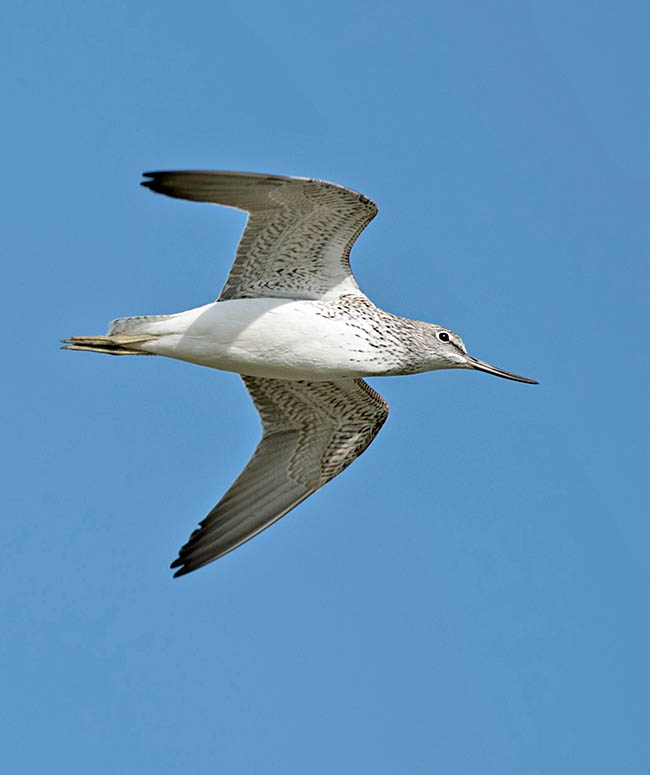
The Common greenshank (Tringa nebularia) is a shy migratory bird, but at times joins with other species of waders © Gianfranco Colombo
There is a great mess in the marshes in spring, when all limicolous gather, crammed in small spaces, on the way of their return to the nesting sites, mixed and taken by the urge to feed in order to recover the strength for leaving, thus creating that nice mix so much appreciated by the birdwatchers.
For the truth, the same turmoil recurs also in early autumn, on the way towards the winter quarters, but in this case, they do not show that irrepressible impetus they show in spring.
In this tangle of small birds of various size, among songs and shouts of all kinds, between flutterings and nervous flights, between an unstoppable coming and going in the shallow water while looking for food, like excited ants, only few are able to stand out and be recognized without fail, one of these being the Common greenshank.
Its continuous and plaintive song is one of the signs revealing its presence: a più più più più, quickly repeated and almost always in triplets.
On the other hand, it should not be easy to distinguish it among the overwhelming toddle of tens, even hundreds of small limicolous birds almost of the same dimensions, if not by means of its sad and plaintive shouting.
The Common greenshank (Tringa nebularia Gunnerus, 1767), belongs to the order of the Charadriiformes and to the family of the Scolopacidae and is a limicolous bird well present in the Palaearctic birdlife and easy to be mistaken, from far away, with two of its congeners, the Common redshank (Tringa totanus) and the Marsh sandpiper (Tringa stagnatilis).
Its habitual frequenting swampy sites, has earned it, in Italy, the common name of “Pantana” (“pantano” in Italian means morass), even if observing the local names we can note the more or less onomatopoeic repetition of its habitual song and its colours: Pivlot, Cucalet, Chiò chiò, Gambetta reale, Sgambettun, Verderello, Totanon, Totanasso.
Also, in France, with a simple “Chevalier aboyeur” (barking knight), they have indicated for this bird its two more evident characteristics: knight, due to its long legs similar to the dangling legs of a knight when on a horse, and barking for the continuous call it emits. In English, it’s Common Greenshank, as well as in Portuguese, Perna verde comun and, in German, with Grûnschenkel, due to the green colour of its legs, whilst in Spanish is Archibele claro.
The scientific binomen, conversely, recalls Greek and Latin traditions and etymologies, with some intrusions of old Nordic languages.
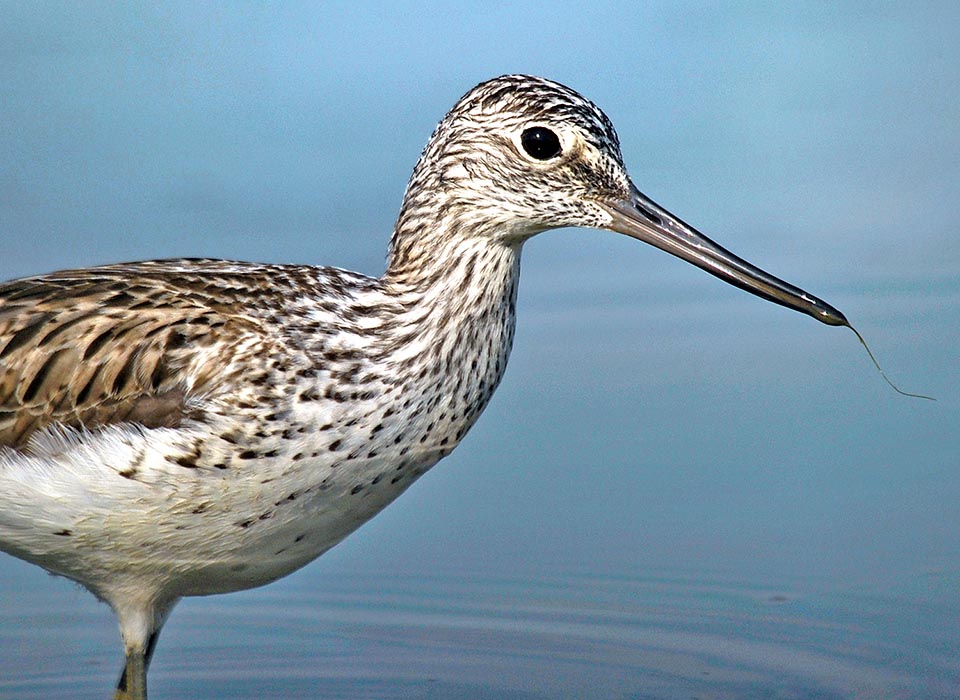
Is recognizable by the sad and plaintive sound and the beak slightly upturned in its final part © Gianfranco Colombo
Tringa from an old Greek term “Trungas”, with which Archimedes identified an aquatic bird having the white rump of the size of a thrush, never identified with certainty, but that, presumably, was a Marsh sandpiper.
Nebularia from the Latin “nebula” = fog, to describe the environment where this bird lives, a Latinism created by Gunnerus himself, thus repeating the name given in Norway, in ancient times, to this bird: Skodde føll, = colt of the sand.
Zoogeography
The Common Greenshank is a Palaearctic bird, diffusely present in the northern areas of Asia and Europe at fairly high latitudes, at the limit of the inhospitable tundras of the Arctic and of Siberia. It nests in Scotland and in the whole Scandinavian Peninsula and the Kola Peninsula to then continue east through Russia and Siberia, up to Kamtchatka.
The southernmost nesting points are rightly in Scotland and in some islands of the Baltic Sea, in the gulf of Finland, continuing east, always over the 55th parallel. It is absent in Iceland and in the North Atlantic islands, if not accidentally.

Palaearctic bird, nidifies in the northern areas of Asia and of Europe at rather high latitudes, up to the inhospitable tundras of the Arctic © Gianfranco Colombo
Some specimens, during their migration southwards, exceptionally go down, involved by other migrants, through North America, but these are cases considered as extraordinary.
The Common greenshank is a long range migrant and can reach sites of the austral hemisphere well far from their regular goals. All European populations and of western Asia ones migrate to sub-Saharan Africa, diffusely invading all the continent and reaching even South Africa. Only occasionally and in particular situations, some hundreds of specimens may spend the bad season in the Mediterranean area, but probably they do fall within the percentage of erratism to which the young individuals are often subject.
The eastern part of Africa, with the Rift Valley, is more affected by this migratory flow and sees, from early July, the arrival of a good number of these limicolous who will remain in these quarters even up to late April. Also, the coasts of the Arabian peninsula and of the Persian Gulf, hold a good number of winter migrants.
The central and eastern Asian populations, conversely, reach the Indian subcontinent, the Indo-Malayan areas and all Australian coasts.
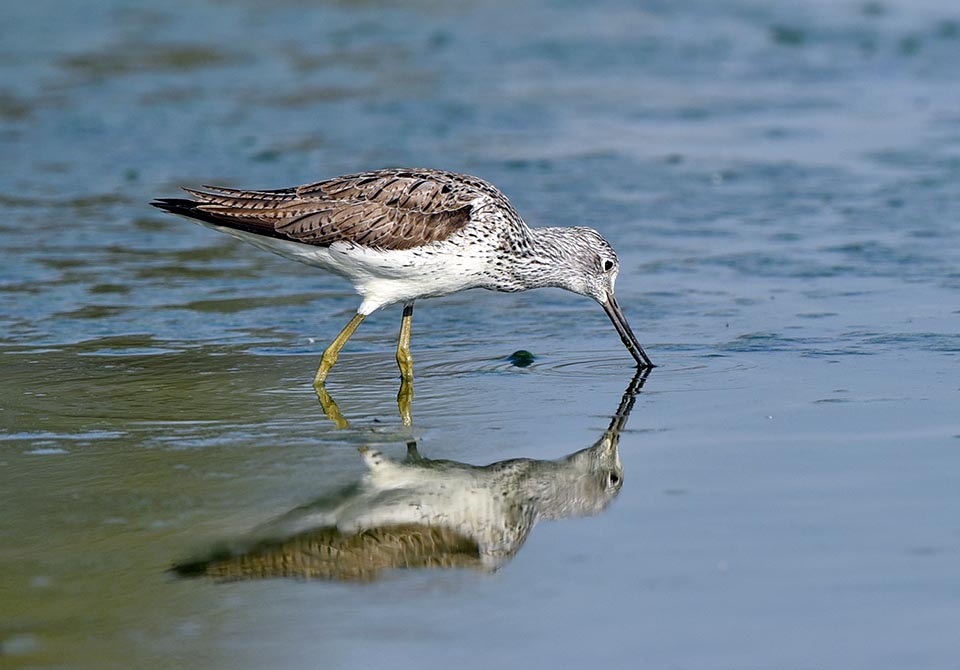
Insectivorous, does not disdain molluscs, crustaceans and small amphibians living in the even stagnant water bodies it finds along its way © Gianfranco Colombo
Ecology-Habitat
Typical limicolous bird, the Common Greenshank is a regular visitor of ponds and swamps, lakes and littorals, salty lagoons and banks of large rivers, just for resting few days and recover strength for restarting.
The nesting sites are the typical humid zones of the taiga, in open areas between large forests, or even in totally barren, with no vegetation, areas, formed by small water streams or by peaty lands having stagnant puddles and with a rather open grassy covering the facilitates the visibility as well as the walking.
It is a reserved bird who never gathers in numerous groups, not even during the migration and this characteristic it has is evidenced during the nidification when retiring to couple life until the reproduction is completed. Its song is typical in these windy areas of the extreme north and the sound propagates over long distances mixing with the noise of that remote and still wild nature.
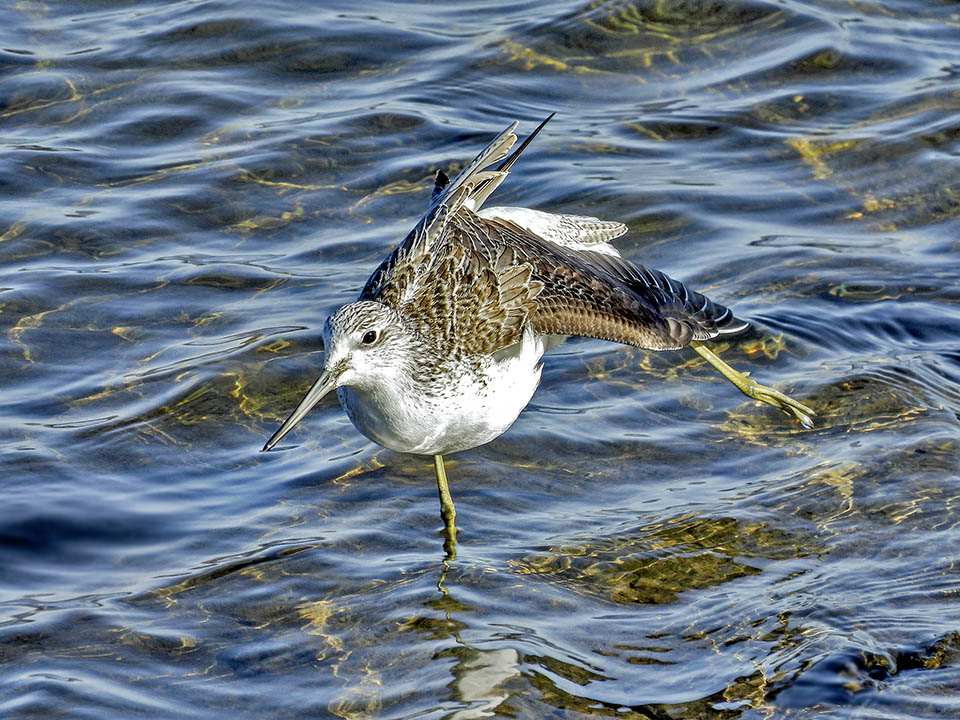
This is in the brackish water of the Guadalhorce old delta where, in the migratory time, can be seen even 90 species of birds per day © Ignacio Barrionuevo
Morphophysiology
The Common Greenshank is the biggest species in its genus. It is 35 cm long, has an average weight of 200 g and a wingspan of 70 cm.
Though mistakeable with other congeners, it is immediately and easily recognizable when close to it, as the conformation of the bill renders it almost unique in its genus.
A long bill, string and shrp, in the final part slightly upturned but that stands out in a quite evident way.
Moreover, it is to be kept in mind that the Common greenshank has usually greenish legs, well elongated on the body, slender and always clearly visible, as these birds adore walking in the shallow waters or even on simply muddy puddles.
When flying, the legs protrude from the tail showing the feet completely.
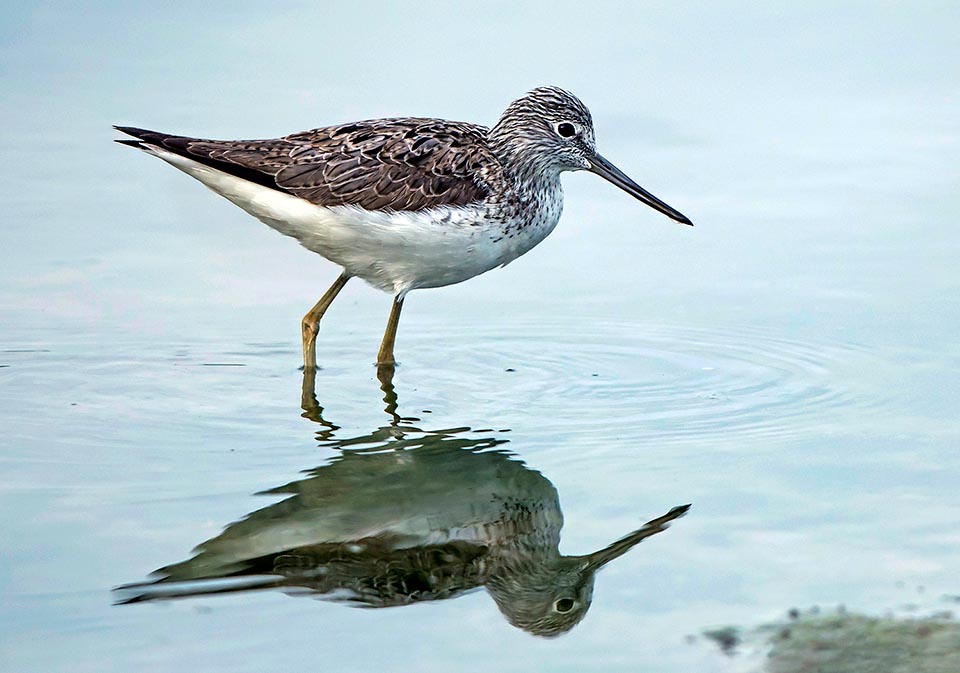
The mantle is much darker than the abdomen and shows a compact greyish colour contrasting with the chest mottled by spots and black striae © Gianfranco Colombo
The colour is usually greyish all over the body but tends to whitish so much to make it look like, if flying, a bird looking clearer than what it actually is. The plumage is much darker than the abdomen and displays a compact dark grey colour contrasting with the white chest mottled with black spots and streaks.
The rump is very white and blends with the overtail and the tail itself that have the same colour: well visible characteristic when in flight and perhaps the reason making this bird to look as white-black instead of greyish. The head is grey, mottled on the top by more or less marked veins.
Often are seen specimens so much clear in their livery to lead to hypothesized cases of leucism, whilst they are simple stages of moulting evidencing plumages clearer than usual.
There is no sexual dimorphism and the young display even in the first year a livery almost similar to the adults. Sexing and determination of the age, are complex operations, done by ornithological specialists.
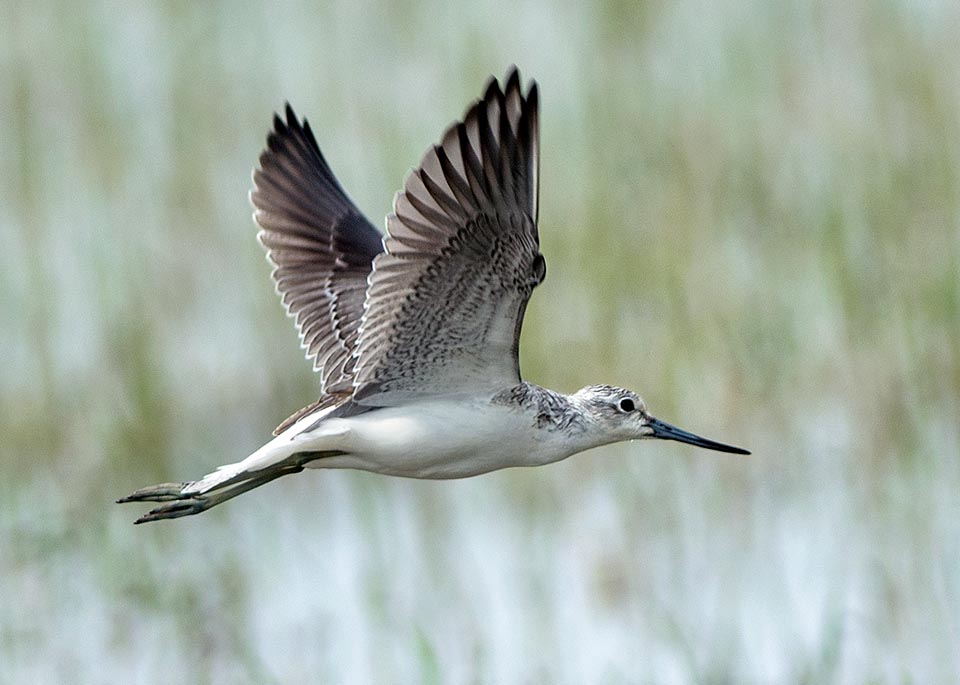
The Common greenshank is the biggest species in its genus. Can be 35 cm long with an average weight of 200 g and a wingspan of 70 cm © Gianfranco Colombo
Ethology-Reproductive Biology
The couple is monogamous and may last longer than one nesting season. The nest is a simple depression on the ground, usually with addition of some material collected nearby, thus rendering it camouflaged with the neighbouring environment, surrounded by lichens, low grasses and small shrubs or stuck to a trunk fallen on the ground or a big stone.
Are usually laid 4 greenish eggs, highly pyriform and diffusely spotted with strong brown variegations. Brooding is done by both parents for about 25 days and the small nidifugous are born with a soft down allowing them to leave the nest immediately after the hatch.
The young will fly away after 30 days more, or even if they will be independent of their parents, some time before. As a matter of fact, the growth is accelerated by the fact that the Common greenshanks are birds nourishing also during the nights, especially in the sub-arctic territories, where they have even 24 hours of light available.
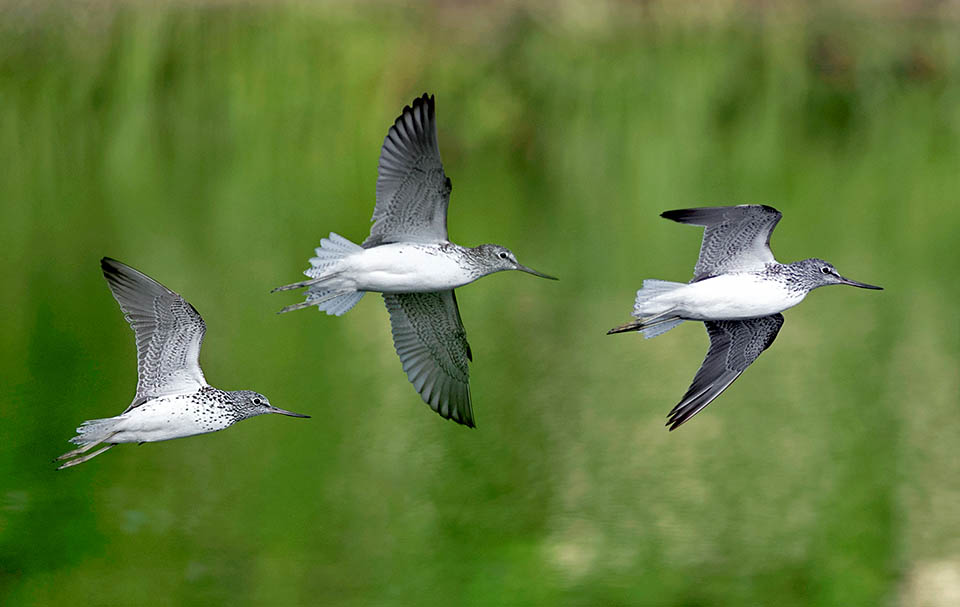
The couples are often faithful for several seasons. The nest is usually made in the ground and the nidifugous kids are born in a soft down. They can live even 15 years © Gianfranco Colombo
Usually, the female leaves the territory before the male and even before that the kids learn to fly. In fact, the newborns do not migrate together with their parents, but with other recently born similars, perhaps following other adults. It appears that the Common greenshank reaches the maturity by around the third year, and that the young, besides migrating southwards on the first winter, do remain in the winter quarters also in the following year or, at least, part of them come back alone to their native sites without more or less reaching them wandering around in the northern hemisphere until the new autumn comes.
The Common greenshank is insectivorous but does not disdain even molluscs, small crustaceans and small amphibians. Usually, the insects and their larvae form the main part of their feeding, but it is reported that even small rodents and minute reptilians are at times prey of their bills.
This bird has a fairly long-life expectancy that may reach the 15 years, consequently, seeing the consistency of the populations and the size of the inhabited area, the species is not considered as under risk.
Synonyms
Scolopax nebularia Gunnerus, 1767.
→ For general information about the Charadriiformes please click here.
→ To appreciate the biodiversity within the CHARADRIIFORMES please click here.
